Three-Dimensional Structure Analysis and Droplet Spectrum Characteristics of Southwest Vortex Precipitation System Based on GPM-DPR
Abstract
:1. Introduction
2. Data and Methods
2.1. Satellite Observation Data
2.2. Discrimination Method of Southwest Vortex
2.3. Classification of Life Stages
2.4. Data Statistical Methods
3. Analysis of Results
3.1. Case Studies
3.1.1. Identification of Precipitation Systems
3.1.2. Vertical Distribution Characteristics of the Reflectivity Factor
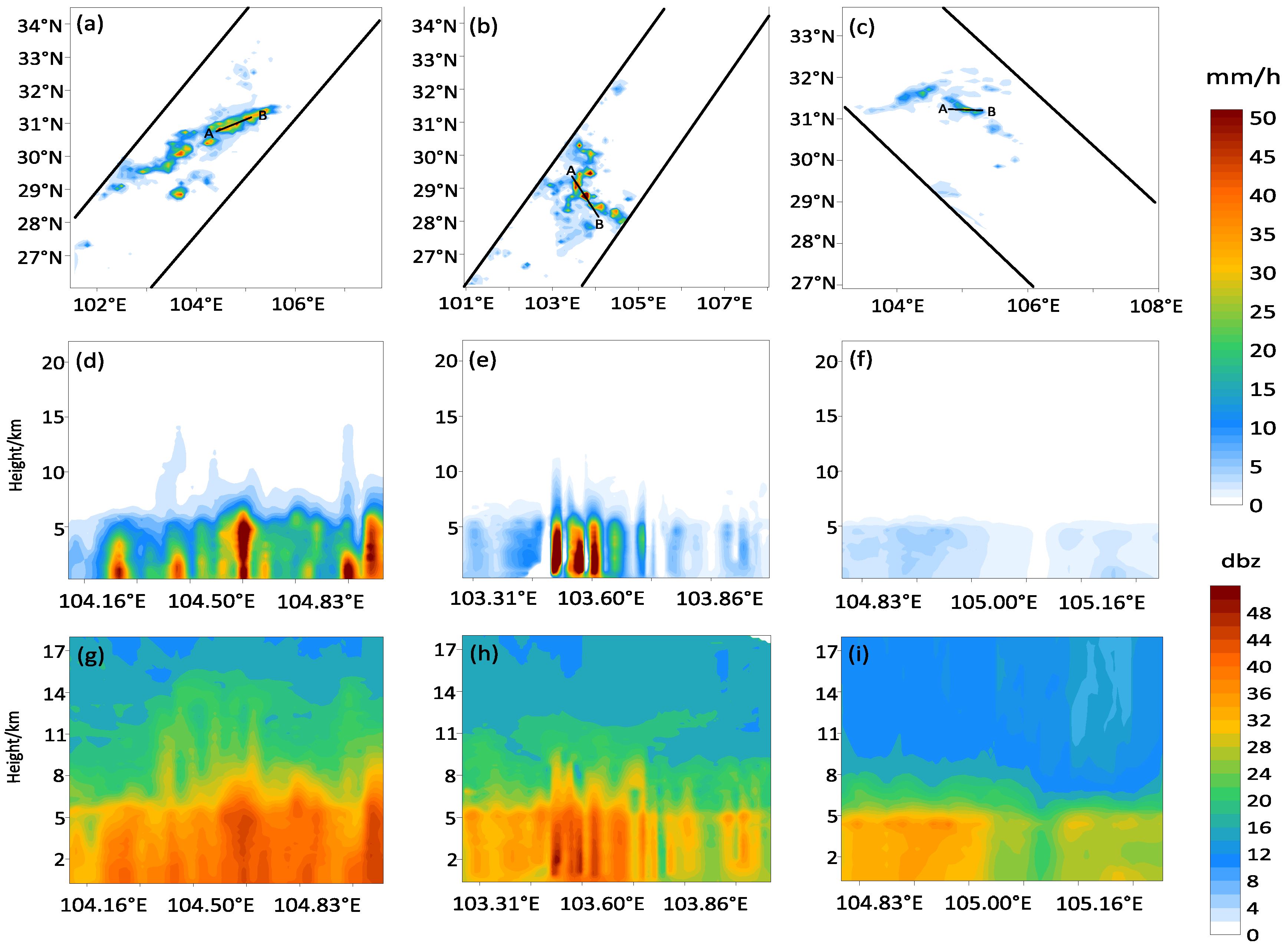
3.2. Statistical Analysis
3.2.1. Vertical Distribution Characteristics of Reflectivity and Precipitation Rate
3.2.2. Droplet Size Distribution
4. Conclusions
- From the three selected cases, the SP particles grow rapidly near the ML when they slowly descend from the upper layer and have a bright band effect. The reflectivity increases slightly below the bright band, indicating that the collision and coalescence process of raindrops in the two types of precipitation clouds slightly overwhelms the surface evaporation process during the fall of the lower layer. In the developing and mature stages of CP, there are two strong reflectivity distribution centers at 8–10 and 2–4 km, respectively, showing characteristics related to terrain. The high-level hydrometeor particles are mainly composed of solid precipitation particles, and the low-level hydrometeor particles collide and coalesce in the violent vertical motion of the airflow.
- In the statistical analysis of the three life stages of the Southwest Vortex precipitation system, the structural characteristics of the developing and mature stages are similar. The primary rainfall type of the Southwest Vortex system is SP, and the SP samples contribute greatly to the total rainfall, with contribution rates of 55.7%, 59.5%, and 74.2%. Compared with CP, the trend of the SP profile is less different from typical cases, but in CP, the reflectivity below the bright band shows a rapid weakening trend toward the surface first and then remains unchanged, which makes its vertical structure change significantly.
- The life stage has a more significant impact on the DSD parameters of CP, and the effect of Dm is more important than the effect of dBNw. The Dm of raindrop particles at each height level is largest in the developing and mature stages, and the difference between these is small. The largest Dm leads to the highest precipitation rate in the developing period, while the Dm in the dissipating stage is smaller, so the precipitation rate is also the lowest. The profile of DSD parameters shows that in the two types of cloud precipitation, the developing stage is composed of large and sparse precipitation particles, the mature stage is composed of large and dense precipitation particles, and the dissipating stage is generally composed of small and sparse precipitation particles.
Author Contributions
Funding
Data Availability Statement
Acknowledgments
Conflicts of Interest
References
- Chen, H.; Sun, L.; Cifelli, R.; Xie, P. Deep learning for bias correction of satellite retrievals of orographic precipitation. IEEE Trans. Geosci. Remote Sens. 2022, 60, 4104611. [Google Scholar] [CrossRef]
- Lin, W.; Wen, C.; Wen, Z.; Gang, H. Drought in Southwest China: A review. Atmos. Ocean. Sci. Lett. 2015, 8, 339–344. [Google Scholar]
- Wang, H.; Wei, M.; Li, G.; Zhou, S.; Zeng, Q. Analysis of precipitable water vapor from GPS measurements in Chengdu region: Distribution and evolution characteristics in autumn. Adv. Space Res. 2013, 52, 656–667. [Google Scholar] [CrossRef]
- Fu, S.; Sun, J.; Zhao, S.; Li, W. The energy budget of a southwest vortex with heavy rainfall over South China. Adv. Atmos. Sci. 2011, 28, 709–724. [Google Scholar] [CrossRef]
- Tang, H.; Fu, S.; Sun, J.; Mai, Z.; Jin, S.; Zhang, Y. Investigation of severe precipitation event caused by an eastward-propagating MCS originating from the Tibetan Plateau and a downstream southwest vortex. Chin. J. Atmos. Sci. 2020, 44, 1275–1290. [Google Scholar]
- Xiang, S.; Li, Y.; Li, D.; Yang, S. An analysis of heavy precipitation caused by a retracing plateau vortex based on TRMM data. Meteorol. Atmos. Phys. 2013, 122, 33–45. [Google Scholar] [CrossRef]
- Yu, S.; Gao, W.; Xiao, D.; Peng, J. Observational facts regarding the joint activities of the southwest vortex and plateau vortex after its departure from the Tibetan Plateau. Adv. Atmos. Sci. 2016, 33, 34–46. [Google Scholar] [CrossRef]
- Chen, Y.; Li, Y.; Zhao, T. Cause analysis on eastward movement of Southwest China vortex and its induced heavy rainfall in South China. Adv. Meteorol. 2015, 2015, 481735. [Google Scholar] [CrossRef]
- Fu, S.; Zhang, J.; Sun, J.; Shen, X. A fourteen-year climatology of the southwest vortex in summer. Atmos. Ocean. Sci. Lett. 2014, 7, 510–514. [Google Scholar]
- Xiang, S.; Li, Y.; Zhai, S.; Peng, J. Comparative analysis of precipitation structures in two Southwest China Vortex events over eastern Sichuan Basin by TRMM. J. Atmos. Sol. Terr. Phys. 2021, 221, 105691. [Google Scholar] [CrossRef]
- Chen, Y.; Li, Y. A thermodynamic condition affecting the movement of a southwest China vortex case. Meteorol. Atmos. Phys. 2022, 134, 36. [Google Scholar] [CrossRef]
- Gao, D.; Li, Y.; Cheng, X. A numerical study on an extreme rainstorm caused by an abnormal-path coupling vortex with the assimilation of southwest China vortex scientific experiment data. In Proceedings of the AGU Fall Meeting Abstracts, San Francisco, CA, USA, 9–13 December 2019; p. A13R-3092. [Google Scholar]
- Kuo, Y.H.; Cheng, L.; Bao, J.W. Numerical simulation of the 1981 Sichuan flood. Part I: Evolution of a mesoscale southwest vortex. Mon. Weather Rev. 1988, 116, 2481–2504. [Google Scholar] [CrossRef]
- Li, L.; Zhang, R.; Wen, M. Diagnostic analysis of the evolution mechanism for a vortex over the Tibetan Plateau in June 2008. Adv. Atmos. Sci. 2011, 28, 797–808. [Google Scholar] [CrossRef]
- Ma, H.; Ma, X.; Jing, Y.; Wu, G. A Study on the mechanisms accounting for the generation of a southwest vortex that caused a series of severe disasters during the 2020 abnormal Meiyu Season. Atmosphere 2021, 12, 556. [Google Scholar] [CrossRef]
- Wang, H.; Wang, L.; He, J.; Ge, F.; Chen, Q.; Tang, S.; Yao, S. Can the GPM IMERG hourly products replicate the variation in precipitation during the wet season over the Sichuan Basin, China? Earth Space Sci. 2020, 7, e2020EA001090. [Google Scholar] [CrossRef]
- Wang, H.; Chandrasekar, V.; He, J.; Shi, Z.; Wang, L. Characteristic analysis of the downburst in Greely, Colorado on 30 July 2017 using WPEA method and X-band radar observations. Atmosphere 2018, 9, 348. [Google Scholar] [CrossRef]
- Wang, L.; Li, Y.; Xu, X. Characteristic Analysis of dual-polarization weather radar echoes of convective precipitation and snowfall in the Mount Everest Region. Atmosphere 2021, 12, 1671. [Google Scholar] [CrossRef]
- Gao, J.; Tang, G.; Hong, Y. Similarities and improvements of GPM dual-frequency precipitation radar (DPR) upon TRMM precipitation radar (PR) in global precipitation rate estimation, type classification and vertical profiling. Remote Sens. 2017, 9, 1142. [Google Scholar] [CrossRef]
- Kotsuki, S.; Terasaki, K.; Miyoshi, T. GPM/DPR precipitation compared with a 3.5-km-resolution NICAM simulation. Sola 2014, 10, 204–209. [Google Scholar] [CrossRef]
- Lu, M.; Wei, M. GPM Data application in analysis of vertical structure of typhoon ‘Mujigae’ precipitation. Remote Sens. Technol. Appl. 2017, 32, 904–912. [Google Scholar]
- Biswas, S.K.; Chandrasekar, V. Cross-validation of observations between the GPM dual-frequency precipitation radar and ground based dual-polarization radars. Remote Sens. 2018, 10, 1773. [Google Scholar] [CrossRef]
- Ryu, J.; Song, H.J.; Sohn, B.J.; Liu, C. Global distribution of three types of drop size distribution representing heavy rainfall from GPM/DPR measurements. Geophys. Res. Lett. 2021, 48, e2020GL090871. [Google Scholar] [CrossRef]
- Sun, Y.; Dong, X.; Cui, W.; Zhou, Z.; Fu, Z.; Zhou, L.; Deng, Y.; Cui, C. Vertical structures of typical Meiyu precipitation events retrieved from GPM-DPR. J. Geophys. Res. Atmos. 2020, 125, e2019JD031466. [Google Scholar] [CrossRef]
- Zhang, Y.; Wu, Z.; Zhang, L.; Xie, Y.; Huang, Y.; Zheng, H. Preliminary study of land–sea microphysics associated with the east asian summer monsoon rainband and its application to GPM DPR. J. Atmos. Ocean. Technol. 2020, 37, 1231–1249. [Google Scholar] [CrossRef]
- Kobayashi, K.; Shige, S.; Yamamoto, M.K. Vertical gradient of stratiform radar reflectivity below the bright band from the Tropics to the extratropical latitudes seen by GPM. Q. J. R. Meteorol. Soc. 2018, 144, 165–175. [Google Scholar] [CrossRef]
- Mu, D.; Li, Y. Statistical characteristics summary of the Southwest China Vortex. J. Arid Meteorol. 2017, 35, 175. (In Chinese) [Google Scholar]
- Li, H.; Moisseev, D. Melting layer attenuation at Ka-and W-bands as derived from multifrequency radar Doppler spectra observations. J. Geophys. Res. Atmos. 2019, 124, 9520–9533. [Google Scholar] [CrossRef]
- Le, M.; Chandrasekar, V. Precipitation type classification method for dual-frequency precipitation radar (DPR) onboard the GPM. IEEE Trans. Geosci. Remote Sens. 2012, 51, 1784–1790. [Google Scholar] [CrossRef]
- Awaka, J.; Le, M.; Chandrasekar, V.; Yoshida, N.; Higashiuwatoko, T.; Kubota, T.; Iguchi, T. Rain type classification algorithm module for GPM dual-frequency precipitation radar. J. Atmos. Ocean. Technol. 2016, 33, 1887–1898. [Google Scholar] [CrossRef]
- Yang, Y.; Chen, X.; Qi, Y. Classification of convective/stratiform echoes in radar reflectivity observations using a fuzzy logic algorithm. J. Geophys. Res. Atmos. 2013, 118, 1896–1905. [Google Scholar] [CrossRef]
- Fu, Y.; Cao, A.; Li, T.; Feng, S.; Zheng, Y.; Liu, Y.; Zhang, A. Climatic characteristics of the storm top altitude for the convective and stratiform precipitation in summer Asia based on measurements of the TRMM precipitation radar. Acta Meteor. Sinica 2012, 70, 436–451. [Google Scholar]
- Fabry, F.; Zawadzki, I. Long-term radar observations of the melting layer of precipitation and their interpretation. J. Atmos. Sci. 1995, 52, 838–851. [Google Scholar] [CrossRef]
- Cao, Q.; Qi, Y. The variability of vertical structure of precipitation in Huaihe River Basin of China: Implications from long-term spaceborne observations with TRMM precipitation radar. Water Resour. Res. 2014, 50, 3690–3705. [Google Scholar] [CrossRef]
- Byers, H.R.; Braham, R.R. The Thunderstorm: Report of the Thunderstorm Project; US Government Printing Office: Washington, DC, USA, 1949. [Google Scholar]
- Robert, A. Cloud clusters and large-scale vertical motions in the tropics. J. Meteorol. Soc. Jpn. 1982, 60, 396–410. [Google Scholar]
- Machado, L.; Rossow, W.; Guedes, R.; Walker, A. Life cycle variations of mesoscale convective systems over the Americas. Mon. Weather Rev. 1998, 126, 1630–1654. [Google Scholar] [CrossRef]
- Yin, J.; Wang, D.; Zhai, G.; Zhien, W. A study of cloud vertical profiles from the CloudSat data over the East Asian Continent. Acta Meteor. Sinica 2013, 71, 121–133. [Google Scholar]
- Fu, Y.; Lin, Y.; Guo, S.; Wang, Q. Seasonal characteristics of precipitation in 1998 over East Asia as derived from TRMM PR. Adv. Atmos. Sci. 2003, 20, 511–529. [Google Scholar]
- Watters, D.; Battaglia, A.; Mroz, K.; Tridon, F. Validation of the GPM version-5 surface rainfall products over Great Britain and Ireland. J. Hydrometeorol. 2018, 19, 1617–1636. [Google Scholar] [CrossRef]
- Johnson, R.H.; Rickenbach, T.M.; Rutledge, S.A.; Ciesielski, P.E.; Schubert, W.H. Trimodal characteristics of tropical convection. J. Clim. 1999, 12, 2397–2418. [Google Scholar] [CrossRef]
- Seo, E.K. Characteristics of summer rainfall over East Asia as observed by TRMM PR. J. Korean Earth Sci. Soc. 2011, 32, 33–45. [Google Scholar] [CrossRef]
- Zhang, J.; Qi, Y. A real-time algorithm for the correction of brightband effects in radar-derived QPE. J. Hydrometeorol. 2010, 11, 1157–1171. [Google Scholar] [CrossRef]
- Zhou, L.; Xu, G.; Xiao, Y.; Wan, R.; Wang, J.; Leng, L. Vertical structures of abrupt heavy rainfall events over Southwest China with complex topography detected by dual-frequency precipitation radar of GPM Satellite. Int. J. Climatol. 2022. [Google Scholar] [CrossRef]
- Zhang, A.; Fu, Y. The structural characteristics of precipitation cases detected by dual-frequency radar of GPM satellite. Chin. J. Atmos. Sci. 2018, 42, 33–51. [Google Scholar]
- Xiang, S.; Li, Y.; Lu, P. Based on TRMM satellite data, the three-dimensional structure characteristics of precipitation in Sichuan Basin are analyzed. Plateau Mt. Meteorol. Res. 2021, 41, 17–23. (In Chinese) [Google Scholar]
- Qi, Y.; Zhang, J. Correction of radar QPE errors associated with low and partially observed brightband layers. J. Hydrometeorol. 2013, 14, 1933–1943. [Google Scholar] [CrossRef]
- Zhang, A.; Fu, Y.; Chen, Y.; Liu, G.; Zhang, X. Impact of the surface wind flow on precipitation characteristics over the southern Himalayas: GPM observations. Atmo. Res. 2018, 202, 10–22. [Google Scholar] [CrossRef]
- Cao, Q.; Zhang, G.; Brandes, E.; Schuur, T.; Ryzhkov, A.; Ikeda, K. Analysis of video disdrometer and polarimetric radar data to characterize rain microphysics in Oklahoma. J. Appl. Meteorol. Climatol. 2008, 47, 2238–2255. [Google Scholar] [CrossRef]
- Tokay, A.; Short, D.A. Evidence from tropical raindrop spectra of the origin of rain from stratiform versus convective clouds. J. Appl. Meteorol. Climatol. 1996, 35, 355–371. [Google Scholar] [CrossRef]
- Ulbrich, C.W. Natural variations in the analytical form of the raindrop size distribution. J. Clim. Appl. Meteorol. 1983, 22, 1764–1775. [Google Scholar] [CrossRef]
- Geerts, B.; Dejene, T. Regional and diurnal variability of the vertical structure of precipitation systems in Africa based on spaceborne radar data. J. Clim. 2005, 18, 893–916. [Google Scholar] [CrossRef]
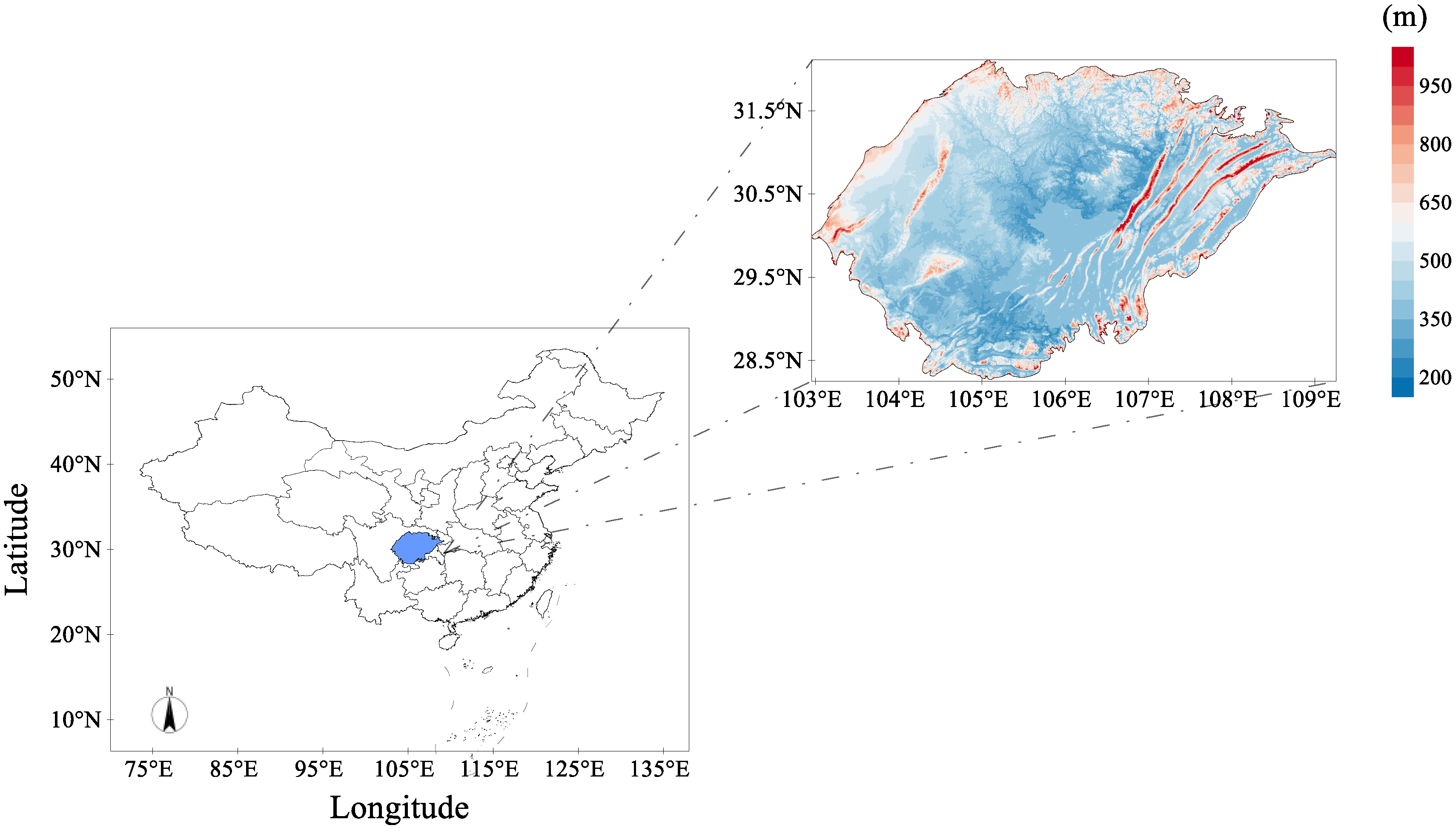
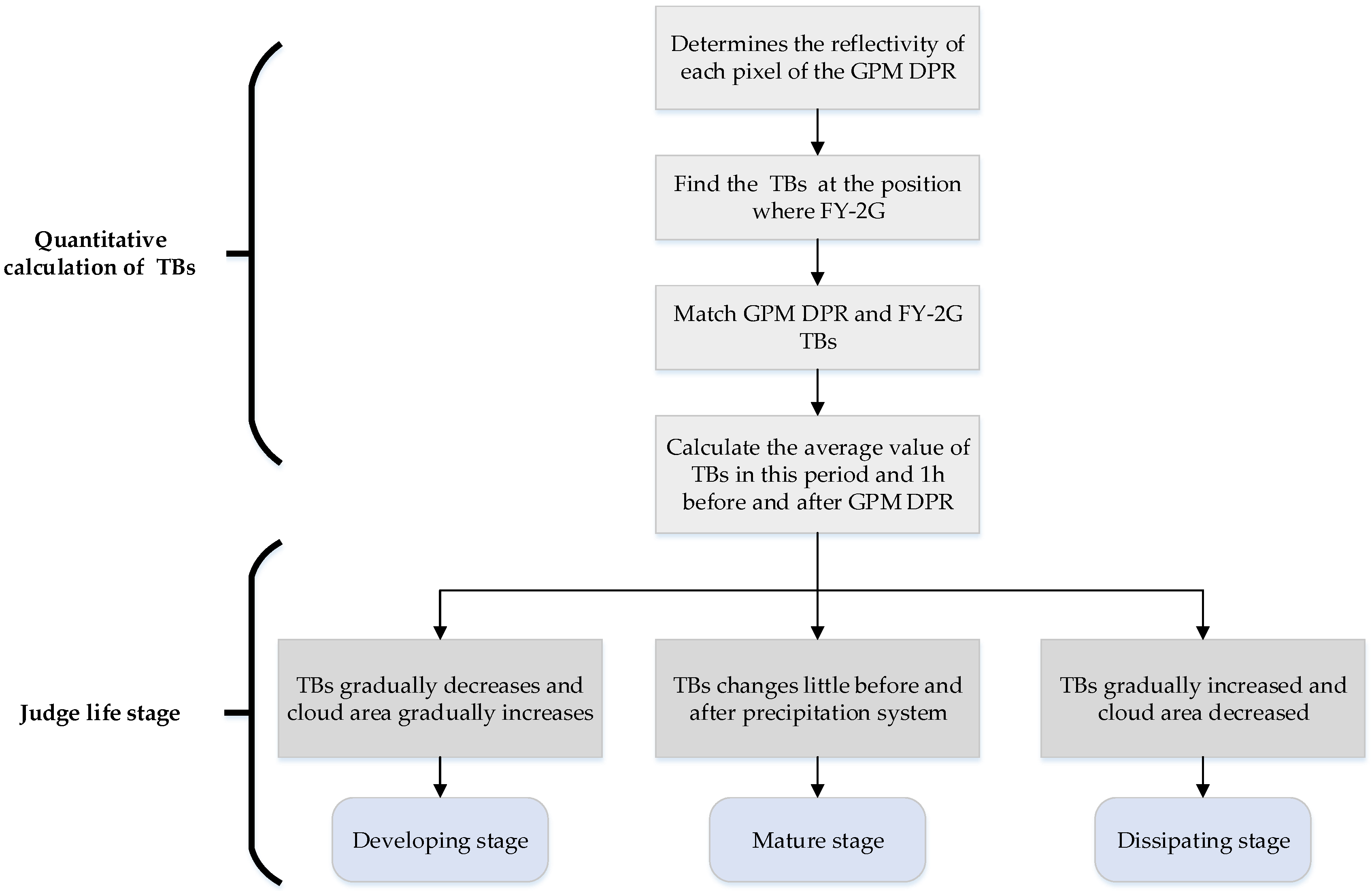
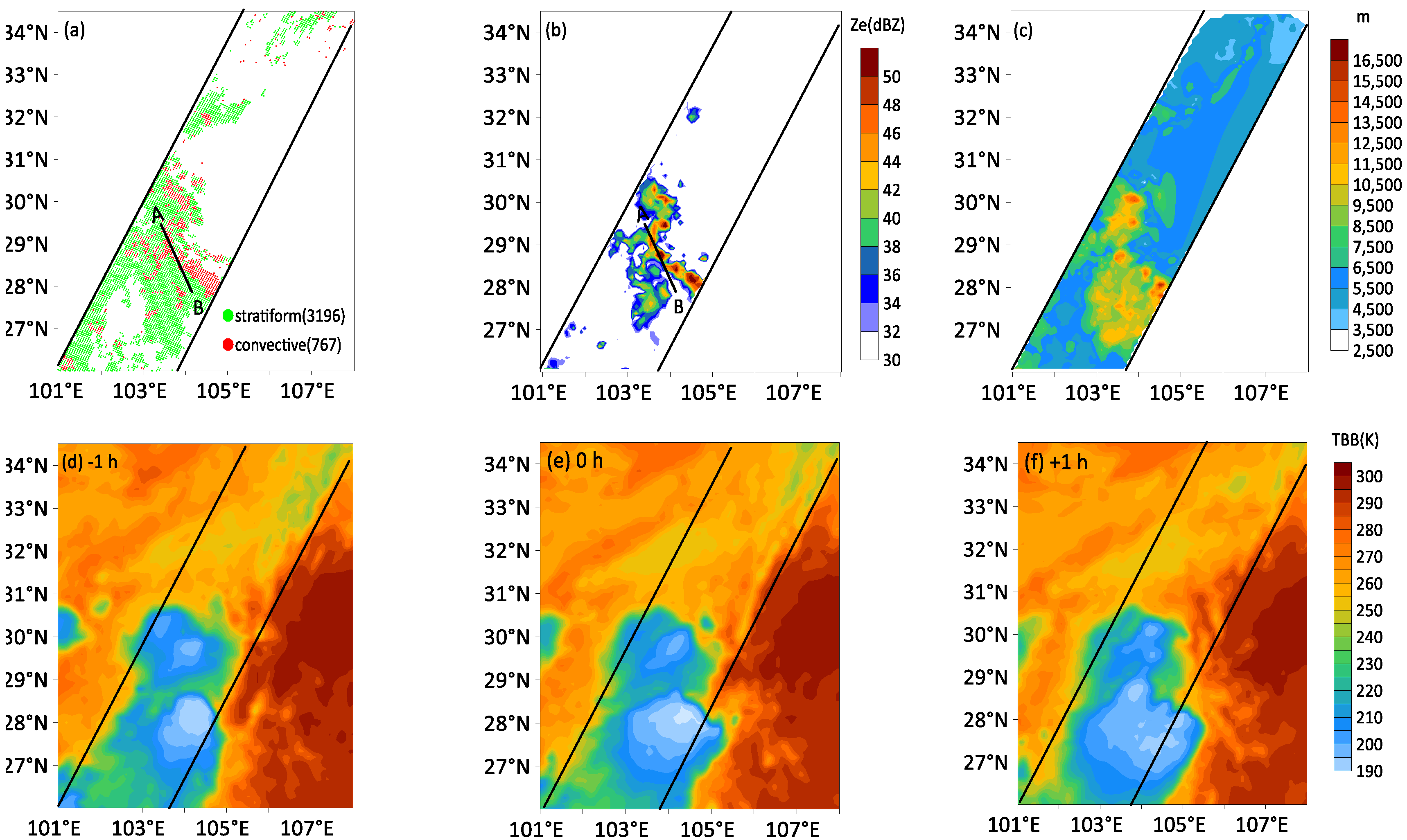
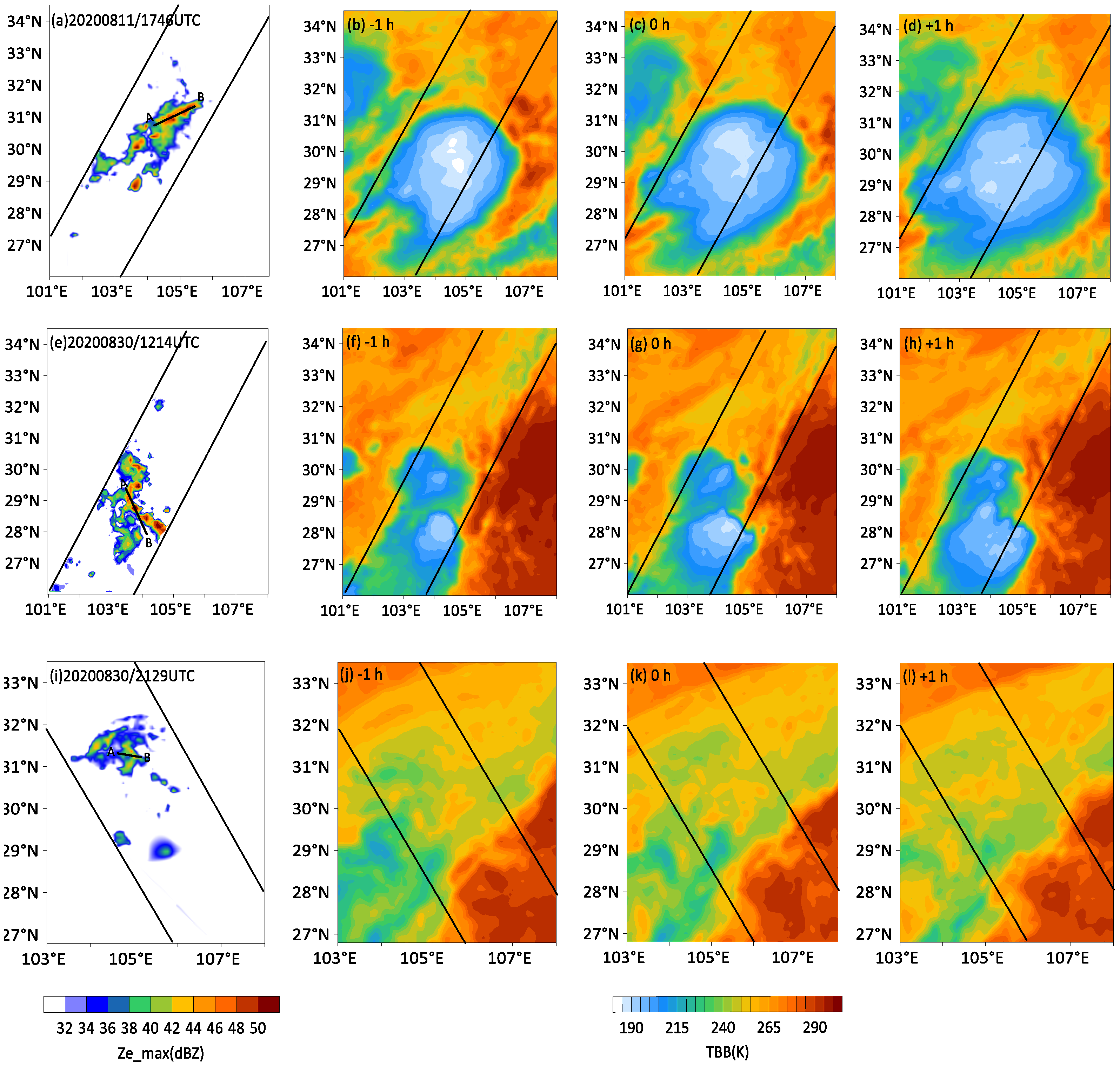
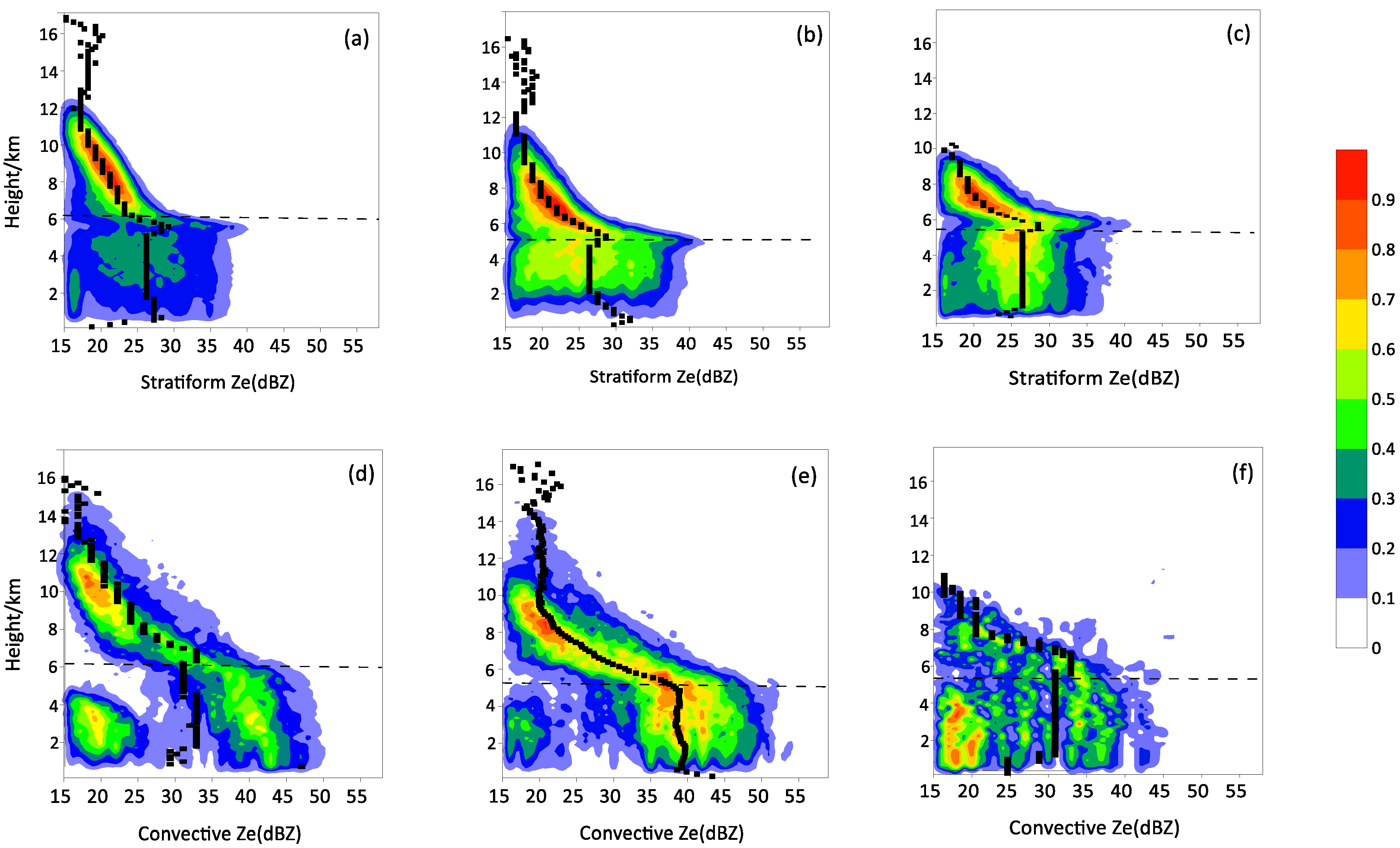
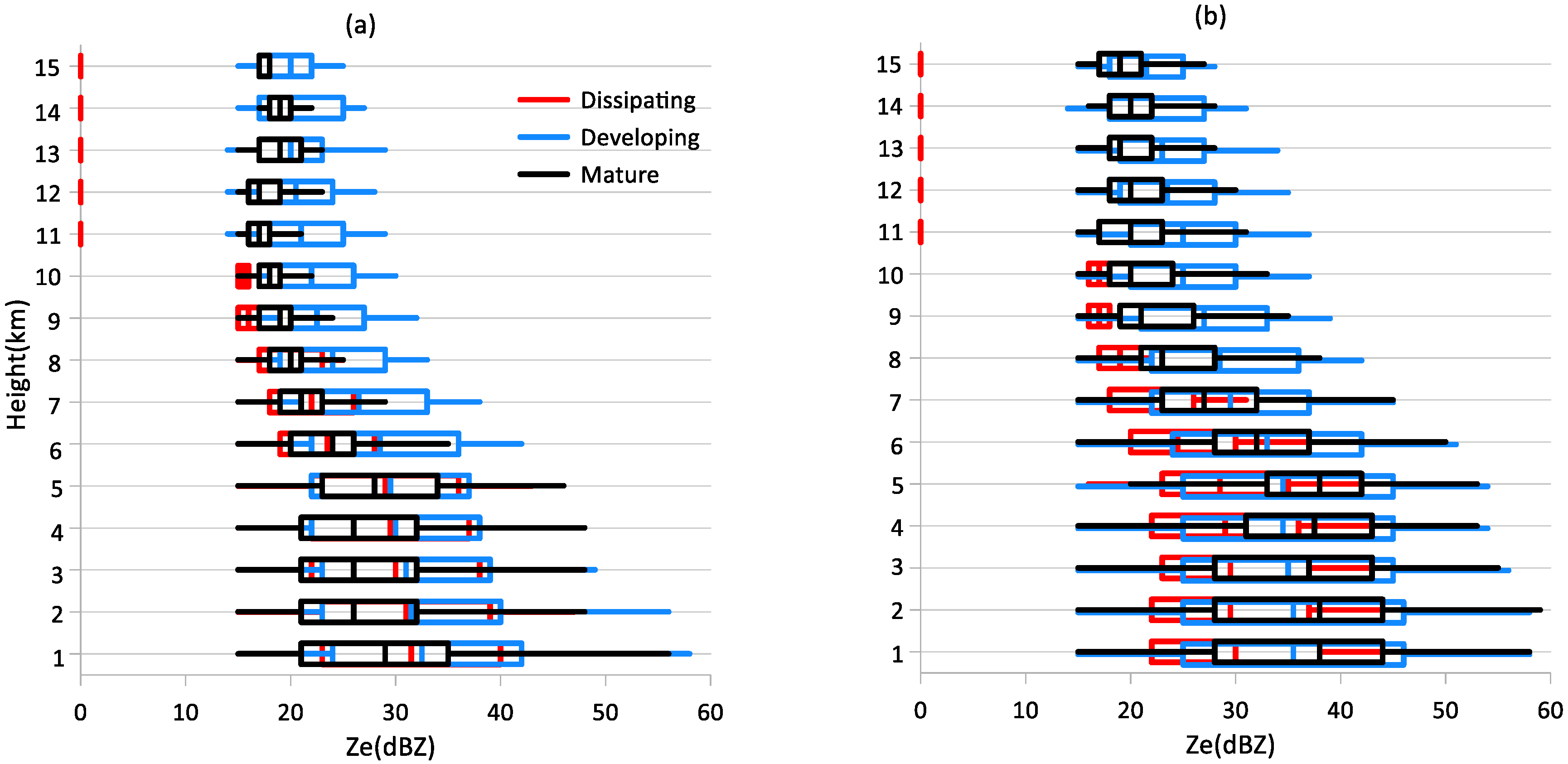
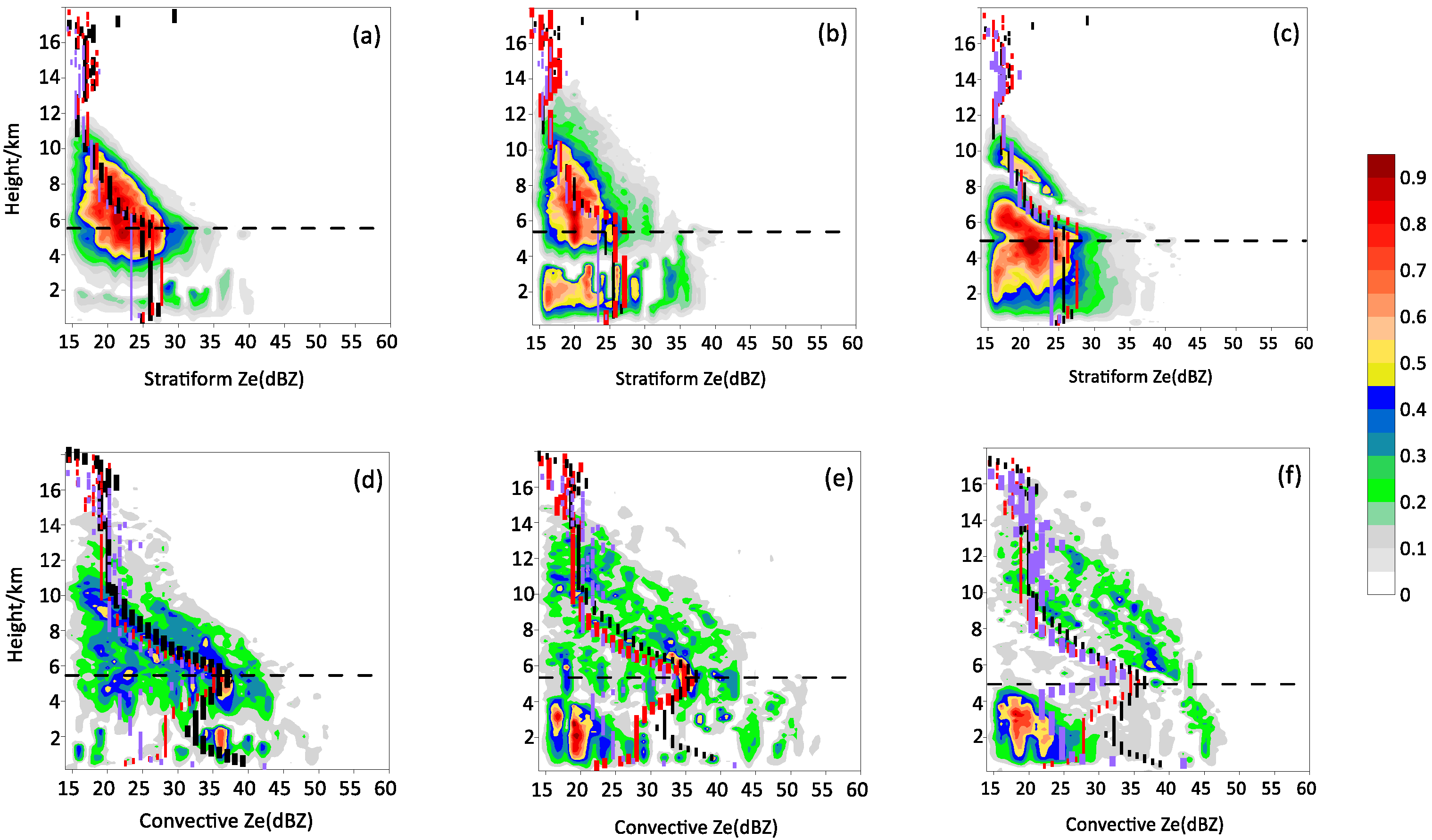
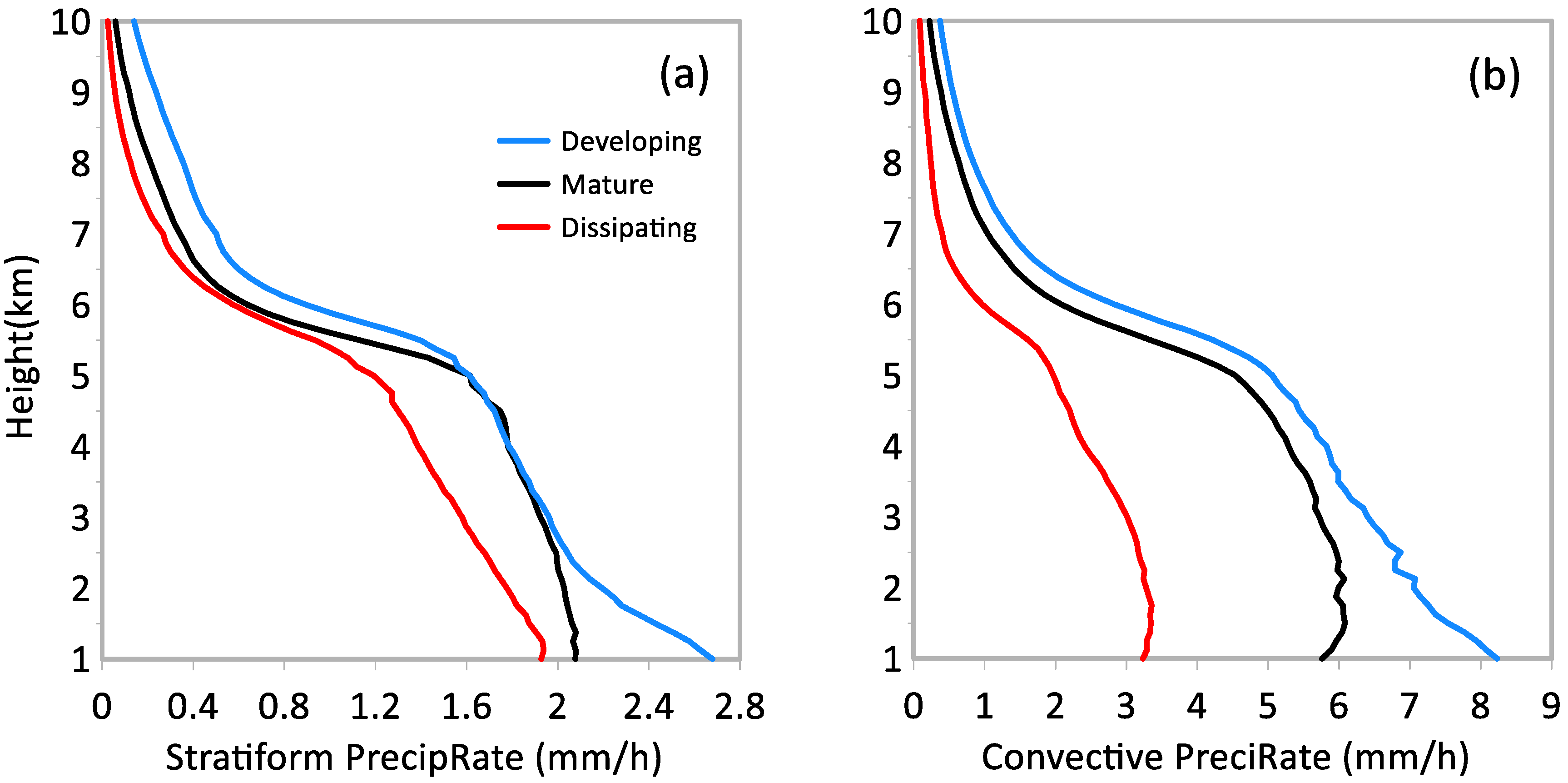
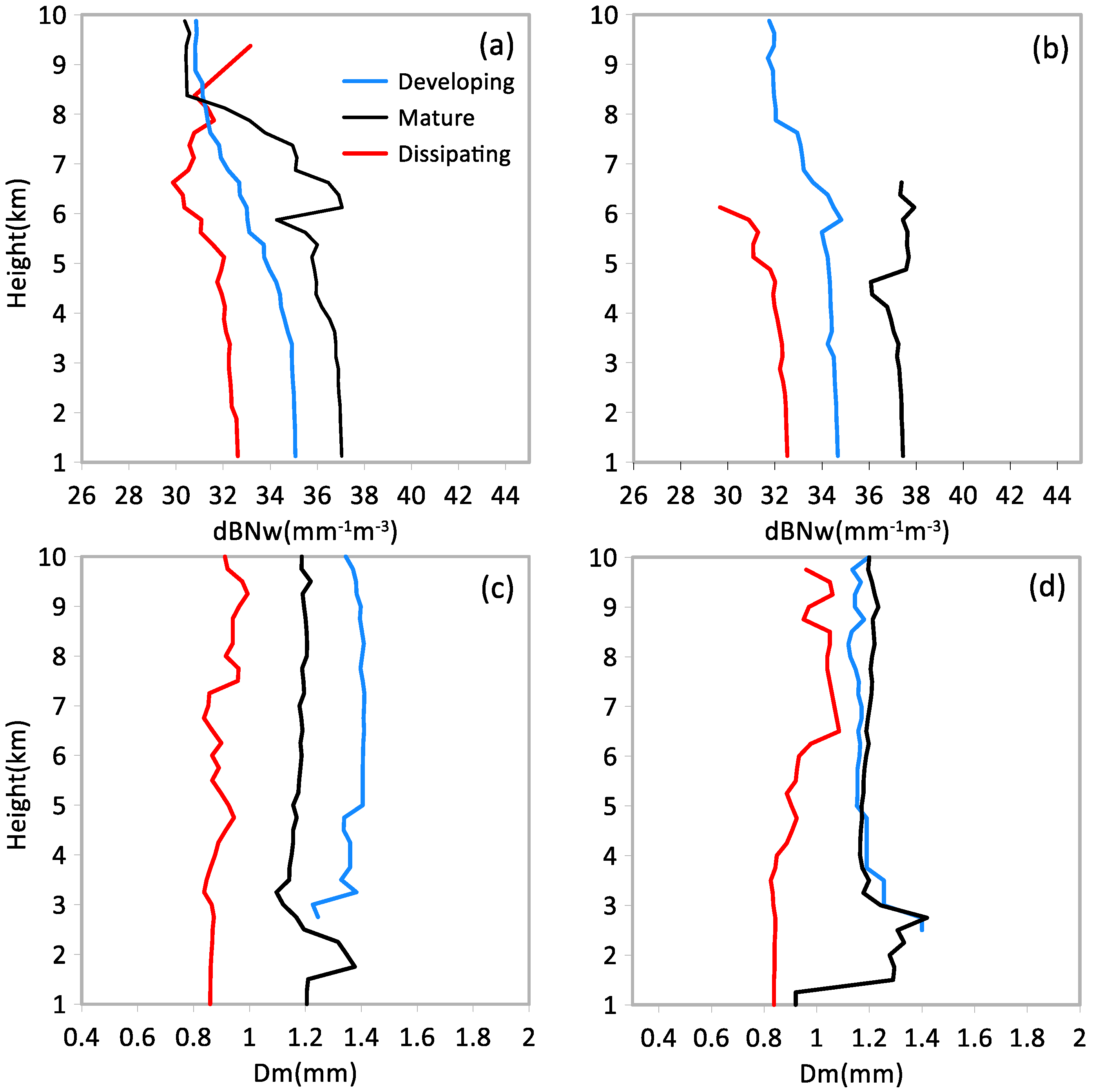
| UTC | Influence System | ||||||
|---|---|---|---|---|---|---|---|
| Year | Month | Day | Hour | 500 hPa | 700 hPa | 850 hPa | Ground |
| 2019 | 7 | 19 | 11 | The low trough between two high pressures | Southwest Vortex | Low vortex | Weak cold air |
| 2019 | 7 | 19 | 21 | The low trough between two high pressures | Southwest Vortex | Low vortex | Weak cold air |
| 2020 | 6 | 26 | 7 | The low trough, with obvious air pressure drop | Shear line, Southwest Vortex | Low vortex | Cold air |
| 2020 | 6 | 29 | 16 | Low vortex | Southwest Vortex | Low vortex | Diffusion of cold air |
| 2020 | 8 | 11 | 17 | Low trough, the air pressure in front of the trough decreases | Southwest Vortex | Low vortex | Hot and low pressure at night, cold air intrusion during the day |
| 2020 | 8 | 30 | 12 | Low vortex | Southwest Vortex | Low vortex | Cold air intrusion |
| 2020 | 8 | 30 | 21 | Low vortex | Southwest Vortex | Low vortex | Cold air intrusion |
| 2020 | 9 | 5 | 19 | Low trough, the air pressure in front of the trough decreases | Southwest Vortex | Low vortex | Warm zone |
| 2021 | 6 | 15 | 23 | Westerly low trough | Shear line and Low Vortex | Shear line and Low vortex | Cold air |
| 2021 | 6 | 16 | 8 | Westerly low trough | Shear line and Low vortex | Shear line and Low vortex | Cold air |
| 2021 | 6 | 28 | 20 | Northwest airflow in front of Tibetan high pressure | Southwest vortex | Low vortex | No cold air effect |
| 2021 | 7 | 9 | 16 | Plateau low trough | Southwest Vortex, Southwest jet | Low vortex, the jet stream | No cold air effect |
| 2021 | 7 | 14 | 15 | Plateau shear line | Southwest Vortex, Southwest jet | Low vortex | Hot and low pressure at night, cold air intrusion during the day |
| 2021 | 7 | 15 | 0 | Low vortex | Southwest Vortex | Low vortex | Cold air |
| 2021 | 7 | 15 | 14 | Low vortex | Southwest Vortex | Low vortex | Cold air |
| 2021 | 8 | 6 | 8 | Plateau shear line | Shear line | Low vortex | No cold air effect |
| 2021 | 8 | 6 | 17 | Plateau shear line | Shear line | Low vortex | No cold air effect |
| 2021 | 8 | 16 | 5 | The shear line between two high pressures | Southwest Vortex | Low vortex | No cold air effect |
| 2021 | 8 | 16 | 15 | The shear line between two high pressures | Southwest Vortex | Low vortex | No cold air effect |
| 2021 | 8 | 17 | 4 | The shear line between two high pressures | Southwest Vortex | Low vortex | No cold air effect |
| 2021 | 8 | 22 | 3 | Plateau low trough | Southwest Vortex, Southwest jet | Low vortex, the jet stream | Cold air during the day |
| 2021 | 8 | 22 | 12 | Plateau low trough | Southwest Vortex, Southwest jet | Low vortex, the jet stream | No cold air effect |
| 2021 | 9 | 4 | 0 | Westerly low trough | Southwest Vortex, Southwest jet | Low vortex | Cold air |
| 2021 | 9 | 4 | 9 | Westerly low trough | Southwest Vortex, Southwest jet | Low vortex | Cold air |
| 2021 | 9 | 4 | 23 | Westerly low trough, edge of line 588 | Southwest Vortex, Southwest jet | Low vortex | Cold air |
| 2021 | 9 | 5 | 8 | Westerly low trough, edge of line 588 | Southwest Vortex, Southwest jet | Low vortex | Cold air |
| 2021 | 9 | 15 | 6 | Westerly low trough, edge of line 588 | Southwest Vortex, Southwest jet | Low vortex | No cold air effect |
| Developing | Mature | Dissipating | |
|---|---|---|---|
| Number of precipitation systems | 9 | 10 | 8 |
| Total pixel samples | 15,000 | 14,773 | 9911 |
| Stratiform pixel samples (SP, %) | 11,367 (75.8%) | 11,258 (76.2%) | 8093 (81.7%) |
| Convective pixel samples (CP, %) | 2635 (17.6%) | 2456 (16.6%) | 1313 (13.2%) |
| Contribution of SP (%) | 55.7% | 59.5% | 74.2% |
| Contribution of CP (%) | 44.3% | 40.4% | 25.7% |
| Average precipitation rate of SP (mm/h) | 1.9430 | 1.9480 | 1.4887 |
| Average precipitation rate of CP (mm/h) | 6.6695 | 6.0807 | 3.1793 |
| Upper 5.0% CP samples (>50 mm/h) | 38 | 36 | 0 |
Publisher’s Note: MDPI stays neutral with regard to jurisdictional claims in published maps and institutional affiliations. |
© 2022 by the authors. Licensee MDPI, Basel, Switzerland. This article is an open access article distributed under the terms and conditions of the Creative Commons Attribution (CC BY) license (https://creativecommons.org/licenses/by/4.0/).
Share and Cite
Wang, H.; Tan, L.; Zhang, F.; Zheng, J.; Liu, Y.; Zeng, Q.; Yan, Y.; Ren, X.; Xiang, J. Three-Dimensional Structure Analysis and Droplet Spectrum Characteristics of Southwest Vortex Precipitation System Based on GPM-DPR. Remote Sens. 2022, 14, 4063. https://doi.org/10.3390/rs14164063
Wang H, Tan L, Zhang F, Zheng J, Liu Y, Zeng Q, Yan Y, Ren X, Xiang J. Three-Dimensional Structure Analysis and Droplet Spectrum Characteristics of Southwest Vortex Precipitation System Based on GPM-DPR. Remote Sensing. 2022; 14(16):4063. https://doi.org/10.3390/rs14164063
Chicago/Turabian StyleWang, Hao, Linyin Tan, Fugui Zhang, Jiafeng Zheng, Yanxia Liu, Qiangyu Zeng, Yilin Yan, Xinyue Ren, and Jie Xiang. 2022. "Three-Dimensional Structure Analysis and Droplet Spectrum Characteristics of Southwest Vortex Precipitation System Based on GPM-DPR" Remote Sensing 14, no. 16: 4063. https://doi.org/10.3390/rs14164063
APA StyleWang, H., Tan, L., Zhang, F., Zheng, J., Liu, Y., Zeng, Q., Yan, Y., Ren, X., & Xiang, J. (2022). Three-Dimensional Structure Analysis and Droplet Spectrum Characteristics of Southwest Vortex Precipitation System Based on GPM-DPR. Remote Sensing, 14(16), 4063. https://doi.org/10.3390/rs14164063









